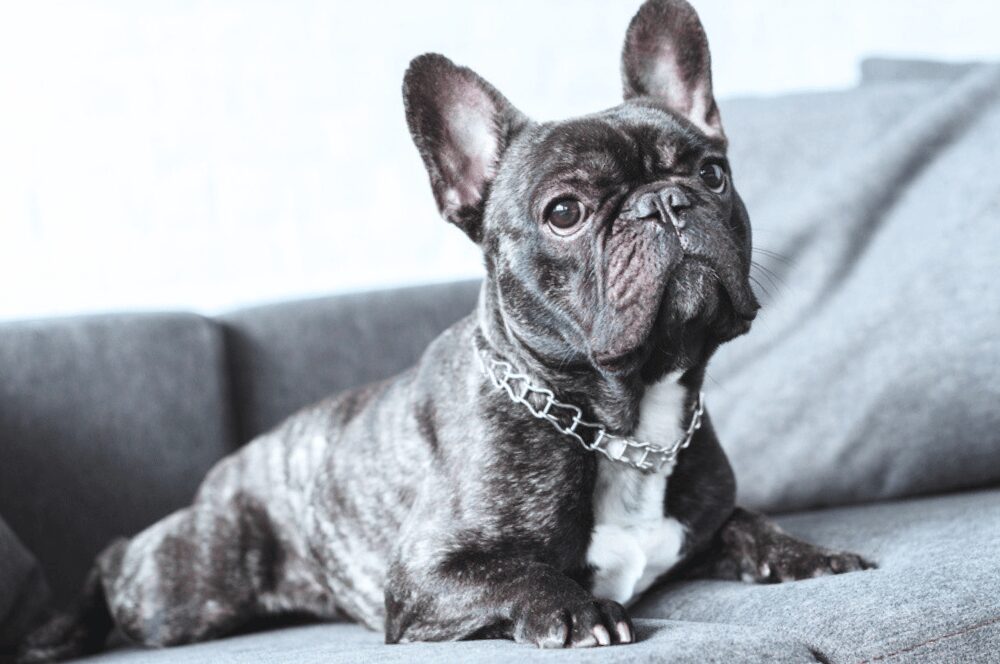It’s easy to overlook gradual changes when we see our dogs every day. But one day something catches our eye—a subtle shift that makes us stop and take a closer look.
As an owner of a black dog, you might have realized that the once deep, ebony coat is no longer the same rich hue it used to be. It’s a change that can creep up slowly, until one day, the difference is undeniable. The black fur that was once a defining characteristic of your beloved pet now shows patches of brown or even rusty red.
Your black dog’s coat might be turning brown because your dog’s diet is missing essential amino acids that make the black pigment. Exposure to sun, seasonal shedding, as well as aging can also make your dog’s coat appear brown. Simple genetics, a skin condition, allergies, and excessive licking can also turn your dog’s coat brown.
In the article below, we’ll explore the 8 reasons your dog could be turning brown, and how to prevent that from happening. So let’s take a closer look!
Reason 1: Coat Shedding And Regrowth (Blowing Their Coat)
Shedding is a normal process and most dogs naturally shed their fur twice a year. Coming spring your dog’s coat will start to shed a bit more, losing their winter layer in preparation for their summer coat, also known as “blowing coat.”
Here’s a video of a Siberian Husky blow out!
Typically, as the old coat ages, it can lose some of its pigment and luster due to factors like sun exposure, natural wear, and environmental influences. This results in the older coat potentially appearing brownish or faded. When the new coat comes in, it often looks darker and more vibrant, reflecting the dog’s natural color more accurately.
Similarly, your dog is likely to shed a second time during autumn, as you can imagine the summer coat will likely look even more brown, because of sun exposure, compared to the thicker black winter coat underneath.
If you have a double-coated breed, then the molting process will be quite significant, and the change in your dog’s coat color could be easier to notice.
However, the extent and pattern of shedding can vary widely among different breeds and individual dogs. Not all black dogs will have a dramatic change in coat color between seasons, and the brown color will usually be subtle.
For instance, my greyhound is completely black, and while his coat is really short, during the shedding season the new coat takes on a shinier darker hue, while the old shed appears grey instead of brown.
Reason 2: Sun Exposure
Like with human hair, prolonged sun exposure can lighten your dog’s coat due to the bleaching effect of UV rays. Not A Bully’s advising veterinarian, Dr. Athena Gaffud explained that “UV rays destroy the coat melanin and dissolve amino acids which are vital components for hair growth.”
So, if your dog spends a lot of time outdoors, especially during the summer then the bleaching effect will be more pronounced.
The change, however, is subtle and often appears as a gradual lightening of the coat’s top layer, especially in black dogs because dark hair is more resistant to photodegradation (the alteration of materials by light) than light hair. So the blacker the melanin the more resistant it is to the effects of the sun.
You are more likely to notice a more pronounced color change on the back and sides, in some cases the chest area, where sun exposure is greatest. I’ve found that this effect can be more noticeable in the longer strands of hair on a longhaired dog.
Sunlight affects every dog differently. The bleaching effect can show up more in dogs that already have reddish or brownish tones in their coat, to begin with. While one dog might spend more time in the sun their black fur might not turn as brown compared to your black dog who might be spending far less time in the sun.
It’s also worth mentioning that excessive sun exposure can be dangerous to your dog’s health. Aside from overheating and dehydration, your dog could get a sunburn where the skin is more exposed.
Reason 3: Genetic Factors
Genetics are complicated, and they play a major role in what your dog will look like, from their gender all the way to their coat color. According to Krista Williams, BSc, DVM, CCRP from VCA, “There are only two basic pigments that determine the color of canines: eumelanin (black) and phaeomelanin (red).”
These pigments can create different variations of coat colors and in the case of your dog, they might explain why their coat has a subtle brown hue which could’ve become more prominent over time due to their breed, environmental factors, aging, or health issues.
Knowing the parents of your dog can also help understand why your dog’s coat might be going from black to brown. That’s because both parents contribute to how your dog’s coat might appear, and it’s possible that they produced black puppies that have a genetic predisposition for their black coat to lighten as they mature, or the brown hues might be more evident as they reach adulthood.
It should be clear by now that not all black dogs share the same genetic makeup. Dr. Gaffud further explained to us that while both parents are black, it is still possible that their offspring (puppy) carries a recessive gene for brown hair. In this case, seeing your puppy’s coat turn brownish would be even more surprising.
Owners of breeds like the Flat-Coated Retriever or Gordon Setter, known for such changes, might observe a gradual transition in color. However, these changes are generally established as part of the breed standard and are evident from a young age, rather than a gradual transition observed only in adulthood.
Reason 4: Aging Process
While that may not apply to all black dogs, as they age, their coat color can change, similar to humans graying. This is due to a decrease in pigment production.
In dogs, this often manifests as a gradual lightening of the coat, with senior dogs showing the most noticeable changes. Owners might notice the color change first around the muzzle and face. However, this change is more typically a graying or whitening rather than turning brown.
The reason it might look brownish could be related to the fact that older dogs also shed more as they age, or they don’t lose the old shed as quickly compared to their energetic young selves who would spend most of their time running around, leaving the coat looking faded and dull.
Additionally, your black puppy could appear to lose some of that black pigment and you may notice a brown or reddish hue appear as their puppy coat naturally gives way to their adult coat. However, this change is usually predetermined by their genetics and it’s specific to the breed.
So, if you observe significant color changes in your dog’s coat, especially if not typical for the breed, you should consult with a veterinarian to rule out any underlying health issues.
Reason 5: Diet And Nutrition
A balanced diet is crucial for maintaining coat health and while drastic coat color changes due to diet are rare, dietary deficiencies in certain amino acids can affect coat pigmentation.
The two amino acids that are responsible for maintaining the black color of your dog’s coat are phenylalanine and tyrosine.
If your dog’s diet doesn’t have enough phenylalanine and tyrosine this can lead to what is reported as “red hair syndrome” because of the reduced production of two types of pigments produced by melanocytes; black eumelanin and brown pheomelanin.
Suboptimal zinc levels can lead to graying hair, and copper deficiency can cause fading of brown or black-pigmented hair. However, the most noticeable effects of such deficiencies are usually related to the coat’s condition, such as being dull or brittle, hair loss, and skin ulsters, rather than a dramatic change in color.
If you are concerned about your dog’s coat health or diet, asking your veterinarian is the best option to ensure your dog’s diet includes essential nutrients.
Reason 6: Skin Conditions
Certain skin conditions can cause localized changes in your dog’s black coat color. These conditions often lead to pigmentation changes around affected areas.
These conditions are also called depigmentation dermatoses. You might notice this change in pigmentation in the stomach area, the ears, and even the face.
In this case, it’s unlikely that your dog’s coat will turn brown, the range in color could be from a lighter black all the way to completely white patches. What causes these conditions? An autoimmune disease, infection, or allergy could cause depigmentation dermatoses.
Aside from color changes you should look for signs like itching, redness, or flakiness, and consult a veterinarian if you suspect that your dog is suffering from a skin condition.
Reason 7: Allergies
Dogs can be allergic to different things like grass, certain foods, and pollen. These allergies can manifest in several ways, including skin irritation and excessive grooming behavior.
Your dog’s tears contain something called porphyrin, a pigment found in many bodily fluids, including tears, saliva, and urine.
When dogs have excessive tearing, usually due to allergies or other eye-related issues, porphyrin can stain the fur around their eyes. This staining often results in a reddish or rusty color, more noticeable in lighter-colored fur.
Allergic reactions can lead to changes in skin and coat color, particularly in areas where your dog excessively licks or scratches. However, these changes are typically more related to skin irritation and damage rather than the allergy itself changing the fur color.
The brownish hues seen in the coat are usually a result of staining from saliva (which also contains porphyrin) rather than a direct result of the allergy. You might also observe redness, swelling, or hair loss in these areas, aside from the brownish hues on the coat.
Reason 8: Excessive Licking
As mentioned above, your dog’s saliva contains porphyrin which can stain your dog’s black coat, specifically in the case of excessive licking. The brown color can usually be seen in localized areas, often in places the dog can easily lick.
The stained fur can appear brown or reddish, especially in lighter-colored coats, but on black coats, the staining might be less noticeable.
Aside from allergies and skin conditions, frequent licking can be caused by stress. Your dog could be licking his fur more than usual to soothe their anxiety which can be a result of boredom, separation anxiety, or a health issue.
The longer you leave your dog’s excessive licking unaddressed you will notice more negative effects affecting your canine companion. Aside from skin and coat discoloration, you may notice hair loss or bald patches, dandruff, redness, and pimple-like lesions, as well as yellow or green discharge, or even limping. These can escalate into more severe skin conditions if not addressed.
Can You Prevent Your Dog’s Coat From Turning Brown?
We all want our dogs to look their best and you can preserve your dog’s black coat by making grooming and coat maintenance part of your regular routine.
By brushing their black coat daily you are preventing matting, getting rid of old hair that may appear brown or reddish, and distributing natural oils throughout the coat.
Even though my greyhound has a really short coat I still make sure to brush him at least once a week, and even more regularly during the shedding season to maintain the glossy shine of his black coat. But if your dog has a thicker coat you will also need de-shedding tools for better results. Regular grooming also helps spot early signs of allergies, or skin conditions.
Depending on the length of your dog’s coat trimming or clipping will help maintain a healthy appearance and make it easier for you to maintain. It can also help keep their black coat from looking dull by getting rid of bleached and brown sections caused by the sun.
How often you bathe your dog should also be tailored to the individual dog’s needs, it could be once a week to only a few times a year. However, you should avoid over-bathing your dog which will result in dry coats and skin problems, and don’t forget to use high-quality products that are designed for dogs.
To keep your dog’s black coat from turning brown you will also need to make sure they are not constantly exposed to the harsh sunlight. If you keep your dog outdoors, or they spend a lot of time outside, make sure they have access to shade, and consider using pet-safe sunscreen to protect their coat, but also their nose and any areas with exposed skin.
If you notice the black coat of your dog suddenly turning brown and/or displaying any unusual changes, whether it’s looking dull, and patchy then you need to take them for a vet check-up to eliminate any possible health issues, whether that’s allergies, skin conditions and even an unbalanced diet.
Final Thoughts
There are many reasons why your black dog’s coat could be turning brown, and it’s important to understand this can happen for various reasons. Observing other signs and symptoms alongside this color change is key to identifying the underlying cause.
Keep a close eye on any unusual changes in your dog’s behavior or appearance, including this shift in fur color. While a change from black to brown is often not a cause for concern, it’s a good practice to be vigilant.
If you notice any other worrying symptoms or if the color change is rapid and significant, it’s wise to consult with your veterinarian. This way, you can ensure your dog remains healthy and happy!





